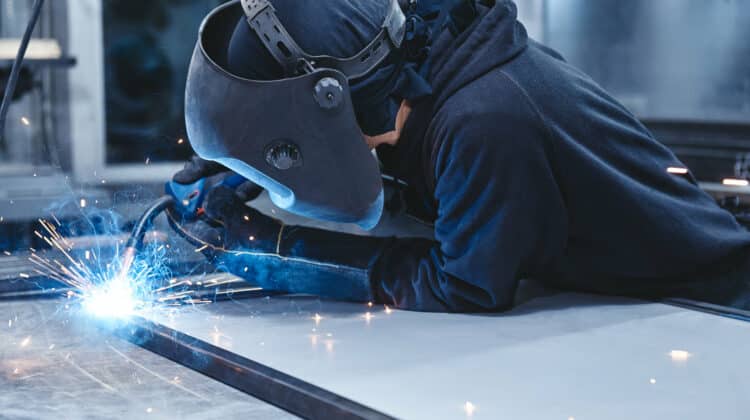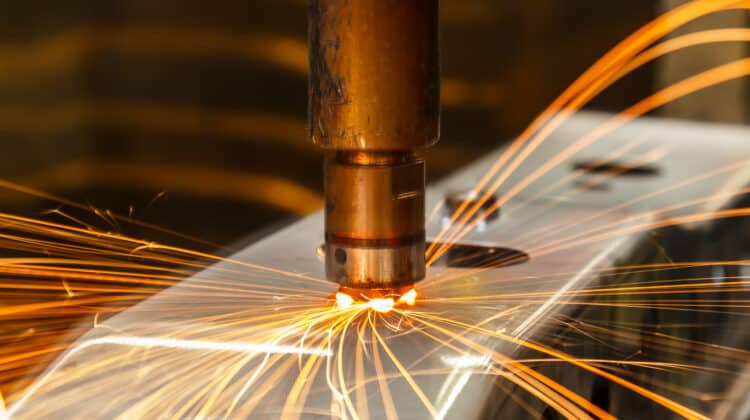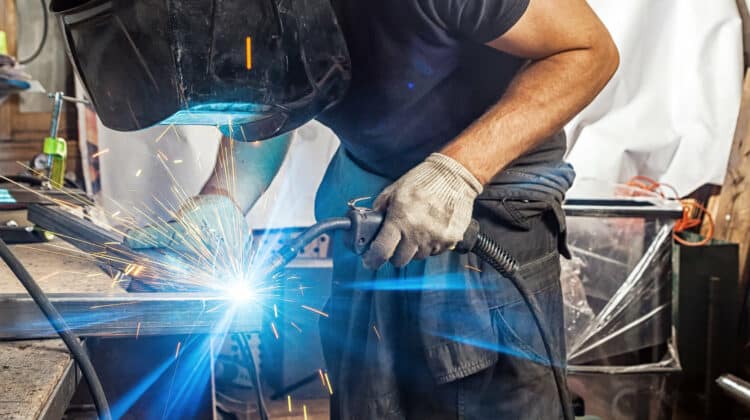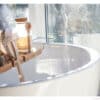What is straight polarity in welding? Usually, straight polarity in welding occurs when the electrode is made negative and the base plate is made positive, causing the electrons to flow from the electrode tip to the base plate.
Table of Contents
Types of polarity
In welding, there are three known types of polarity: 1) direct current straight polarity, 2) direct current reverse polarity, and 3) alternative current polarity.
Direct current straight polarity basically occurs when the electrode to connected to the negative terminal and the plates are made positive. This results in electrons flowing from the electrode tip to the base plates.
On the other hand, with the direct current reverse polarity, electrodes are connected to the positive and plates to the negative which is the reverse of direct current straight polarity. Here also, the electrons flow in an opposite direction, which is from the base plates to the electrode.
If an AC current is generated by the power source, then the straight and reverse polarity will take place after one another in each cycle.
Direct current electrode negative (DCEN) polarity
When the electrode is connected to a negative terminal and the base plate to a positive terminal, it is referred to as Direct Current Electrode Negative or straight polarity. Here, electrons flow from the electrons to the base plates which causes heat concentration at the base plate rather than at the electrode. The direct opposite of what happened in DCEP polarity.
As a result of this, the deposition rate in the electrode reduces, creating a stable and smoother weld. If the base plate is not properly cleaned by the welder, inclusion defects may also be to be found in DCEN.
Unlike in DCEP, where there is decreased penetration, DCEN makes proper penetration possible because of the presence of sufficient fusion of base metals. It also reduces the possibility of tungsten inclusion and decreases reinforcement.
However, there are no oxide cleaning actions here and inclusion defects may pop up. There is also the risk of high residual stress generation as well as a high level of distortion. Low productivity due to a decrease in deposition rate which may occur as a result of wider areas affected by heat.
Direct current electrode positive (DCEP) polarity
DCEP, also known as reverse polarity, occurs when the base plate is connected to a negative terminal and the electrode to the positive. When this happens, the electric current moves from the base plate to the electrode.
Heat concentration is seen in the electrode. The electrons emitted from the base plate are accelerated as a result of the potential difference and hit the electrode at high velocity. This results in the concentration of heat in the electrode tip.
Due to the high concentration of heat at the electrode tip, the electrode melts quickly and there is an increase in deposition rate causing low penetration and fusion in the base plate. DCEP current is ideal when using base plates with dust particles, dirt, or imperfections on the metal’s surface. This is referred to as oxide cleaning action.
There can be issues of the high level of reinforcement if speed is not regulated properly. DCEP also has a much shorter electrode lifespan for non-consumable electrodes.
How do you choose the right polarity?
To select the correct polarity, a level of precision and careful consideration of various factors is required. One of which is the choice of your base metal. Using aluminum or magnesium as your base metal is the best bet as they work better with DCEP because they can rupture the oxide layer that is found on the surface of the plate.
Aluminum and magnesium also both have low melting points, this implies that you would not need high heat generation close to the base plate.
If you choose to use titanium or stainless steel, AC is would work better in this case because using DCEN will only increase the HAZ.
Another factor to consider is the electron emission of the work material as well as the voltage. Using DCEP with a work material that requires high voltage or has low electron emission will produce an unstable arc.
For thinner base plates, DCEP would work better while for thicker base plates, DCEN current is the right polarity, also ensure you undergo edge preparation here.
How does polarity affect arc welding performance?
To create good quality welded materials, polarity is an important factor. The polarity of your weld depends on your fillers such as choice of base metals and type of electrode.
Some of the variables affected by the polarity of a weld include:
- Oxide cleaning –When using plates with imperfections or some amount of dirt on the surface, it is best to go with DCEP current. Oxide cleaning action here will help lower the risk of inclusion defects.
- Reinforcement — By increasing globular metal transfer, the width of the weld bead is also increased due to DCEP polarity.
- Deposition rate — To increase your filler deposition, make sure of consumable electrodes by using DCEP polarity.
- Weld penetration — DCEN polarity equally increases the penetration of your weld.
What is polarity used for in 7018?
It is easy to tell which welding rod is suitable for an electrode from the code.
For instance, from 7018, the first two digits stand for the PSI that the weld can resist. Multiply the first two digits by 1000 to obtain the pressure per square inch. That is 70 by 1000 which gives you 70,000 lbs.
The third digit, in this case 1, helps you determine the position in which the rod can be used.
1 – stands for all positions, 2 – stands for flat or horizontal position, 3 – overhead or vertically up or down, 8 – shows it is low hydrogen potassium and iron powder and is suitable to work with DCEP, DCEN, and AC.
What amp do I need to weld with 7018 rods?
There is no specific amperage that is ideal for welding a 7018 rod. The rule is to determine the amperage to apply by the diameter of the rod.
The diameter can be obtained by the thickness of the metal plate to be welded. For every 7018 rods of 1⁄32 inch electrode diameter, use 30 amp of current. This implies that if the diameter is 2/32 inches, you should use 90 amp of current.
Is the 7018 rod DCEN or DCEP?
Since a 7018 has low-hydrogen powder in it, it is easy to control and produces a smooth weld bead. It is advisable to use a DCEP current on a 7018 electrode.
It can be used with both AC and DC welding applications, and its electrode gives out top-quality x-ray welds as a result of the low-hydrogen iron powder. 7018 electrodes do not need preheating and this makes them ideal for welding applications of medium-grade carbon steel.
Why is DCEP current used for GMAW?
There are numerous reasons why DCEP current is used for GWAM. The first is that using a DCEP current will produce a strong and steady arc, low spatter, deep penetration, smooth metal transfer, and attractive weld bead.
Unlike when DCEN is used on GMAW, it results in large molten beads as well as a large spatter of grain. Although this outcome can be controlled by using wires that contain special chemical compositions for DCEN welding applications.
What polarity do you need to stick weld aluminum?
Welding aluminum is ideal to use direct current electrode positive reverse polarity (DCEP). It is also important to note that the flux of an aluminum stick is inclined to spatter when welding and when it starts cooling off, it creates a ‘muck-like’ look. Also, it is quite hard to lay sufficient beads.
When should you use AC setting on a welder?
In general, you would find that welders choose to use an AC polarity setting when working on metals that are magnetized. AC is half positive and half negative. The welding characteristics are at the center of DC positive and DC negative polarity.
This is why some welders use AC when they want to avoid repair works on rusty metals or other types of deep penetration. AC polarity will provide them less penetration than that of DCEN.





